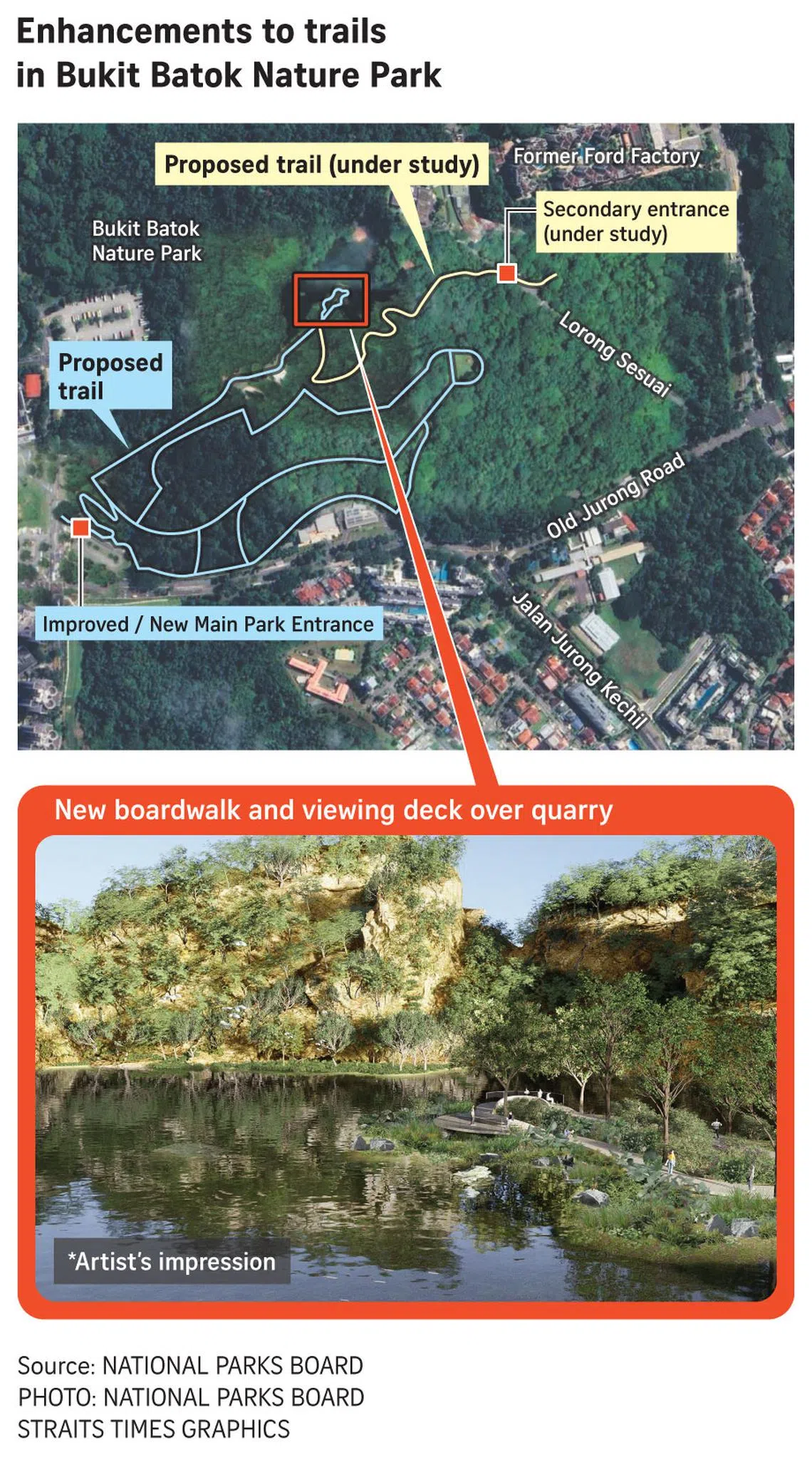New Mandai mangrove and mudflat nature park, enhanced Bukit Batok nature corridor await from 2028
Sign up now: Get ST's newsletters delivered to your inbox
Follow topic:
SINGAPORE – Nature lovers will have a new place to spot migratory shorebirds and get to explore enhanced trails at a refreshed nature corridor from 2028.
The Mandai Mangrove and Mudflat Nature Park – a 72.8ha nature park located about 3km to the east of Sungei Buloh Wetland Reserve – will feature coastal trails and bird hides that allow visitors to observe migratory birds, such as common greenshanks and Pacific golden plovers, without disturbing them.
Visitors to the Bukit Batok Nature Corridor – which consists of over 125ha of nature parks and 10km of trails connecting Bukit Timah Nature Reserve to the future Tengah Forest Corridor – will also be able to enjoy enhanced trails, a new exercise plaza and an “enhanced” stream.
Works for both the Bukit Batok Nature Corridor and Mandai Mangrove and Mudflat Nature Park are expected to start in 2026 and will be completed in phases starting from 2028.
Both projects are part of the National Parks Board’s (NParks) efforts to extend Singapore’s natural capital to help transform the Republic into a City in Nature.
“These efforts not only strengthen our ecological connectivity and extend our natural capital, they also provide Singaporeans with more nature-based recreation opportunities,” said National Development Minister Desmond Lee in a Facebook post on Jan 22.
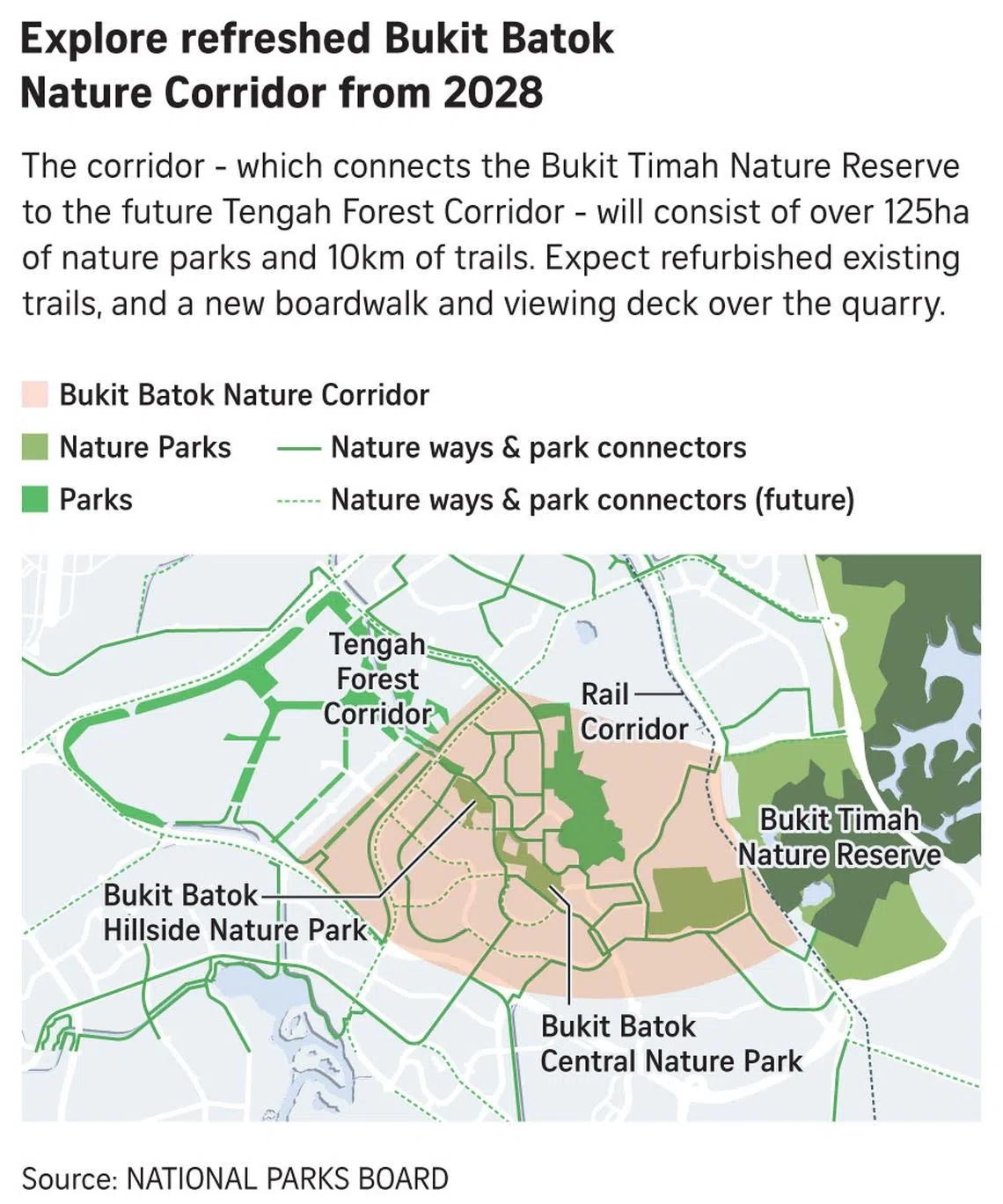
NParks announced in October 2018 that Mandai Mangrove and Mudflat will be conserved as a nature park. Ecologically linked to Sungei Buloh Wetland Reserve, the nature park will enhance the reserve’s ecological capacity in wetland and migratory shorebird conservation.
From 2028, two new nodes, which offer panoramic views of the mudflat, will serve as a place for visitors to learn more about Singapore’s wetland biodiversity and conservation. There will be coach drop-off points at the nature park.
Linking the new nodes are coastal trails with bird hides for bird watchers to observe feathered creatures feeding on the mudflat from a distance.
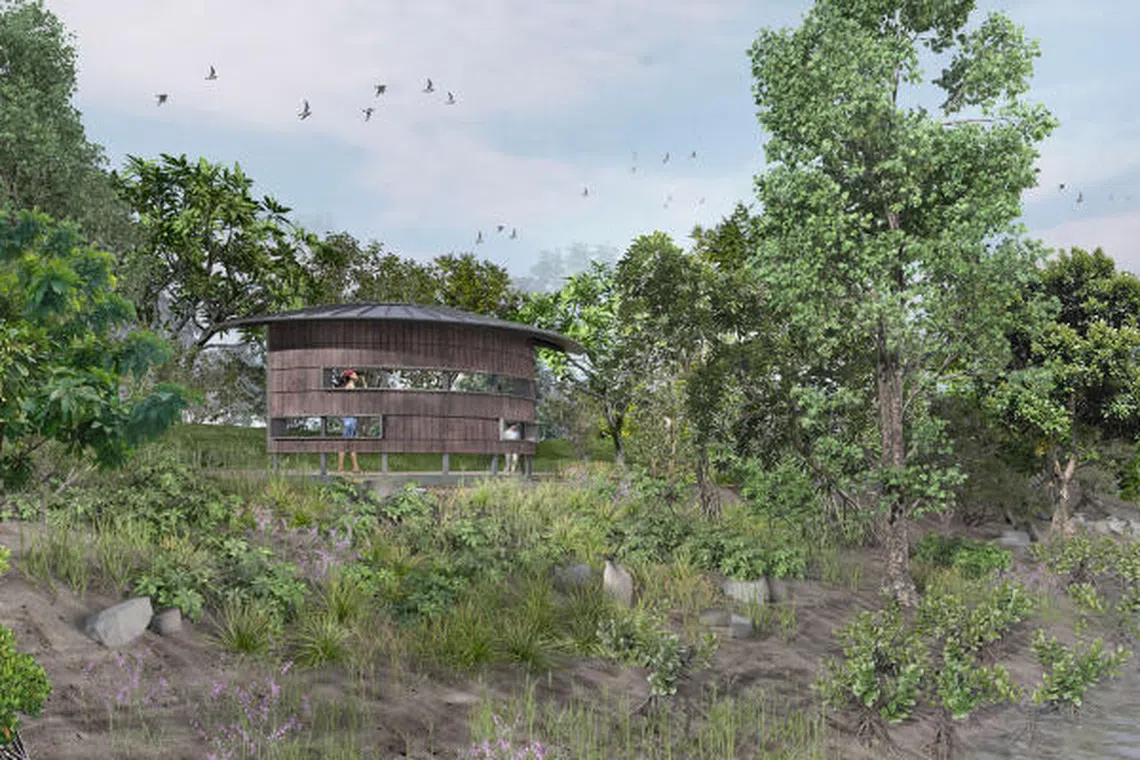
Bird hides along the coastal trail will allow bird watchers to observe the feathered creatures feeding on the mudflat from a distance.
PHOTO: NPARKS
The trails also tap nature-based solutions such as slope-regrading to help restore and reinforce the coasts, as well as support the growth of mangroves.
As one of the richest wetlands in Singapore, the Mandai Mangrove and Mudflat site is home to over 380 fauna species and 190 flora species and is an important feeding ground for migratory shorebirds.
Between August and March yearly, migratory birds escaping the winter chill from the Arctic Circle and Russia stop and refuel in Singapore en route to Australia and New Zealand.
NParks’ studies show that the majority of the shorebirds that roost at Sungei Buloh Wetland Reserve at high tide will fly to Mandai Mangrove during low tide to forage at the mudflat, which is a rich feeding ground for them.
“This means that both sites are ecologically interdependent habitats for shorebirds and are important for shorebird conservation in Singapore,” said NParks.
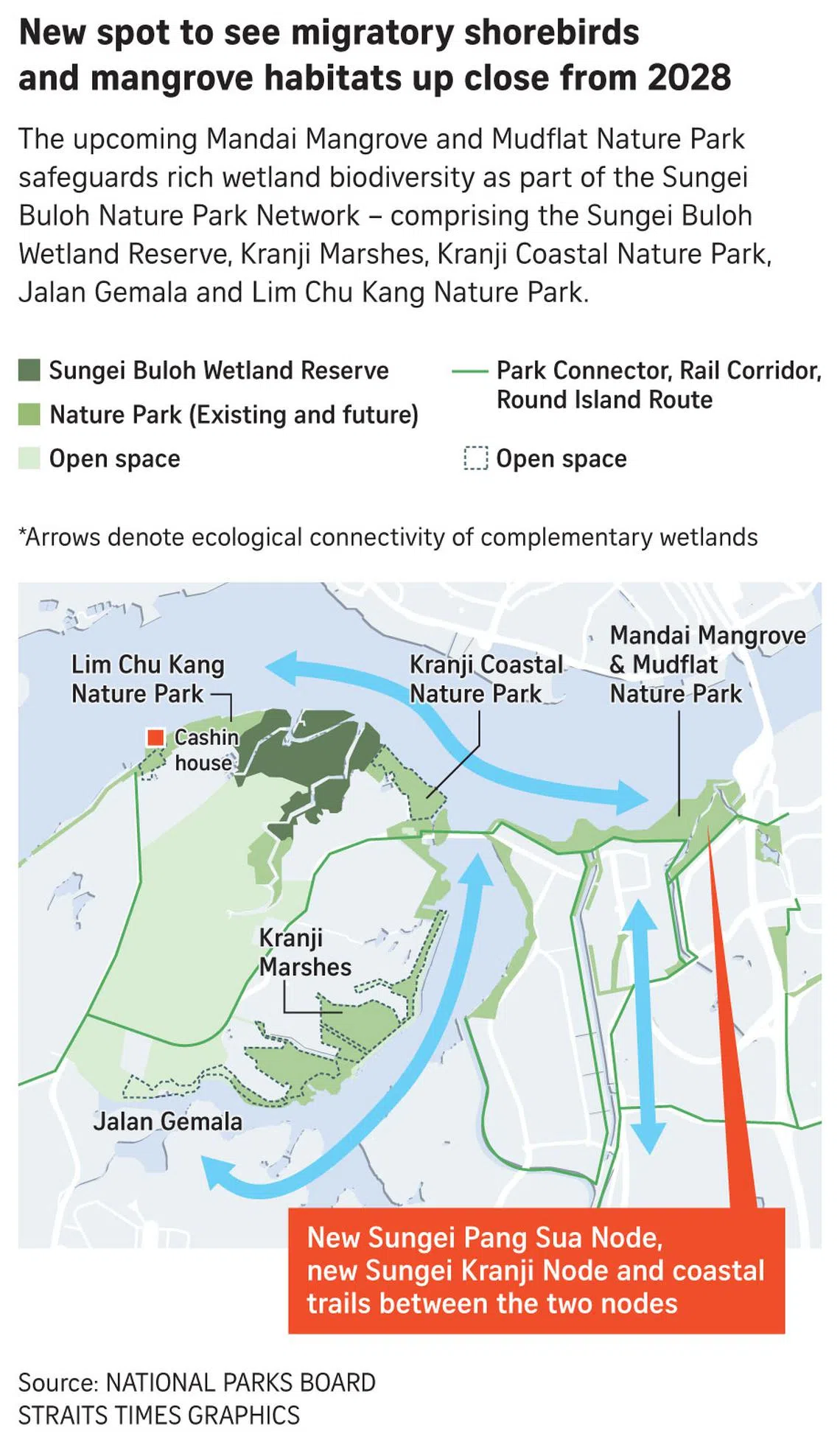
The Mandai Mangrove forest is also one of the few remaining mangrove habitats in Singapore with an extensive mudflat exposed at low tide.
To minimise impact on biodiversity and other parameters such as water quality and sediment quality, NParks, which conducted an environmental impact assessment to guide the development of the site, will avoid heavy construction works during the bird migratory season.
The assessment report will be published in February and members of the public can give their views.
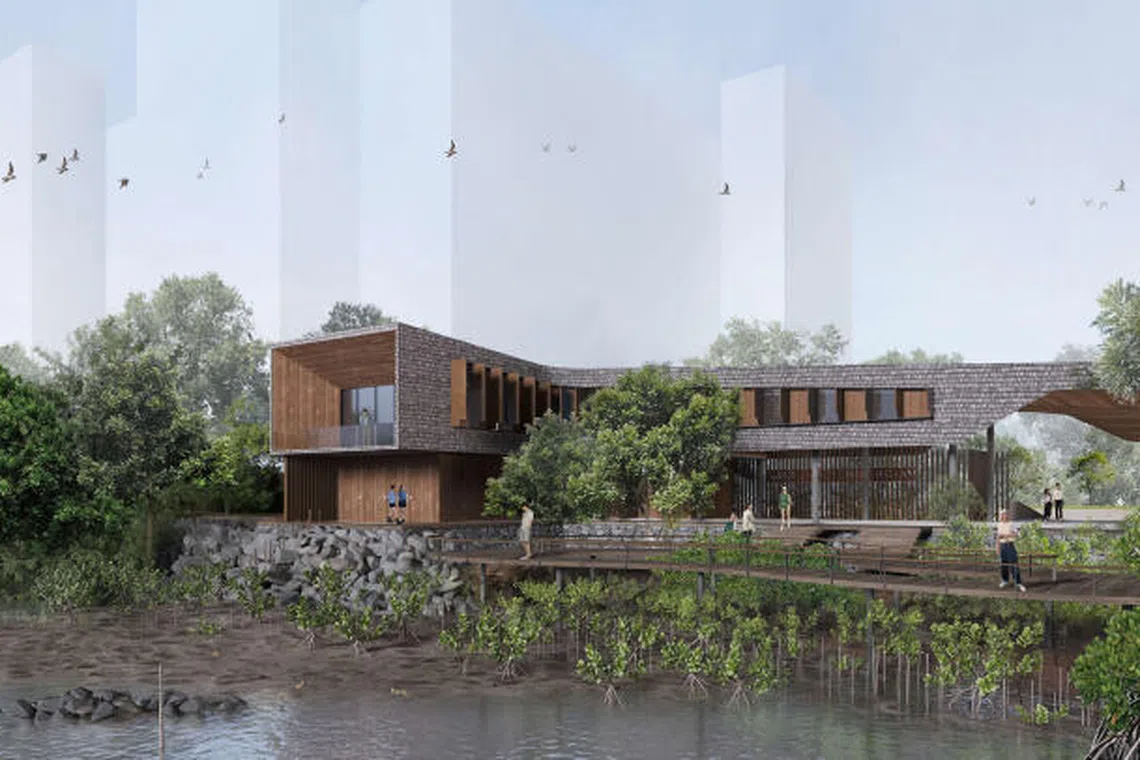
Ecologically linked to Sungei Buloh Wetland Reserve, the nature park will enhance the reserve’s ecological capacity in wetland and migratory shorebird conservation.
PHOTO: NPARKS
At the Bukit Batok Nature Corridor, first announced in December 2020, visitors can look forward to enhanced trails, a new exercise plaza and an enhanced stream. These will be rolled out progressively in 2028.
Such corridors help to support ecological connections between biodiversity-rich areas like nature reserves and parks, which are important for wildlife to move around to find food and mates in other green areas.
Movement of animals like birds and butterflies is also facilitated by 18km of new nature ways – routes planted with specific trees and shrubs that replicate the natural structure of forests – that have been added since 2020 along the corridor. More nature ways will be added, said NParks.
Dr Shawn Lum, a senior lecturer at NTU’s Asian School of the Environment, said enhancing connectivity for wildlife across the areas will help them mitigate isolation amid “a sea of concrete structures and roads”. It will also help less mobile animals, which may also be seed dispersers, to move across landscapes, he added.
The new enhancements to the corridor will be made at Bukit Batok Nature Park, Bukit Batok Town Park and the upcoming Bukit Batok Hillside Nature Park.
At Bukit Batok Nature Park, existing trails will be refurbished with a new boardwalk and view deckings over the quarry. There will also be a new passenger drop-off point for vehicles and shelter at the carpark, in addition to new exercise plazas and a play area for visitors amid a lush setting.
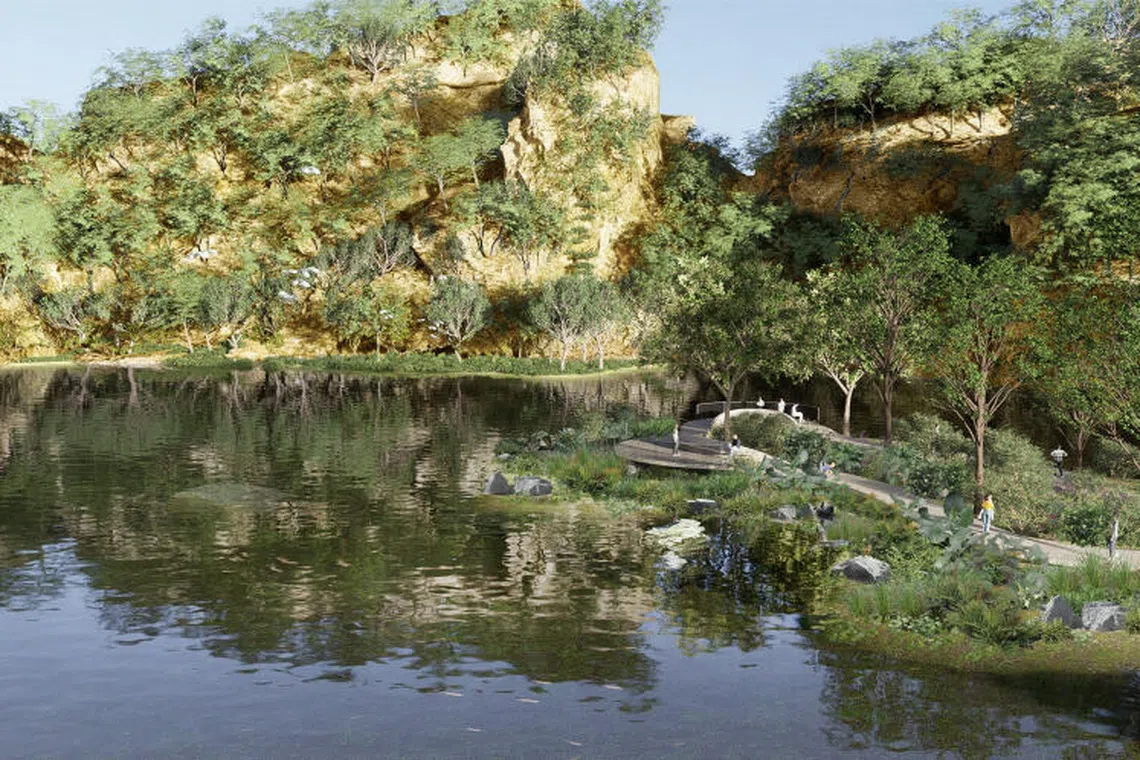
At Bukit Batok Nature Park, existing trails will be refurbished with a new boardwalk and view deckings over the quarry.
PHOTO: NPARKS
The Bukit Batok Town Park will have its existing trails upgraded, plus a new arrival node that comes with a toilet for visitors entering from Bukit Batok Avenue 5.
The new Bukit Batok Hillside Nature Park – at the site of a former park and closed to the public for now – will have a new arrival node and trails.
NParks also plans to enhance the existing stream within the park to provide proper drainage and prevent erosion of the stream’s banks. This will allow visitors to get close and learn about the ecology of the stream.
As part of the environmental impact assessment to guide the development of the site, studies carried out between February 2022 and April 2023 found that at least 200 of the more than 1,200 flora and fauna species recorded are of conservation significance. These include critically endangered plants like the Singapore nervilia orchid and animals like the Sunda pangolin.
The assessment report is available on NParks’ website and is open to public feedback.
To minimise disturbances to the natural environment, mitigation measures, such as avoiding works in forested areas with high conservation value and salvaging plants of conservation significance, will be put in place.
One suggestion, Dr Lum said, is to introduce large seeded plant species, such as wild nutmeg tree species, at these parks as they can help increase the diversity and resilience of the forests.
“More species will increase diversity, and ecological studies have shown that greater diversity makes these forests better able to recover from minor disturbances such as tree falls following strong winds,” he said.
“These large seeded species of primary forests are generally locally uncommon, so finding enough seeds, growing them and introducing them into the redeveloped parks will be laborious and will span decades. But it is not impossible.”
